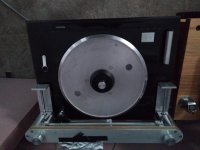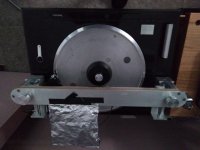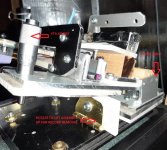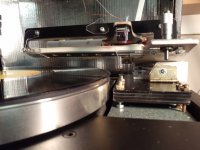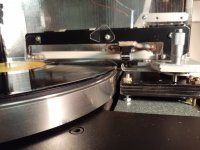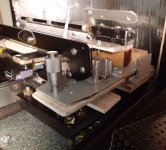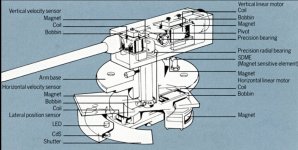Out of curiosity, is there an opinion on passive vs active linear tracking arms? And if active linear tracking arms are superior, are there any opinions on Sony linear tracking arms with biotracer? Like the Sony ps-x555es. I wonder why hasn't these TOTL commercial turntables from 1980s like Sony/Denon/JVC that seemed to solved the damping issues of tonearm gaining traction in our modern times? If they do, then perhaps their linear tracking turntables must have been the solution to tracking error?
I haven't seen any commercial tonearm maker nowadays that utilizes the technology of the JVC/Sony/Denon electronic damping technology. Perhaps they do not have the expertise?
I haven't seen any commercial tonearm maker nowadays that utilizes the technology of the JVC/Sony/Denon electronic damping technology. Perhaps they do not have the expertise?
It would be if the rail was fixed. Mine is designed so the whole rail moves backwards to facilitate changing records. It's held forward by neodymium magnets.
Others have done it differently, Niffy's also moves back and others rotate away from the platter. I wanted mine to be mounted both sides of the rail to increase rigidity.
Others have done it differently, Niffy's also moves back and others rotate away from the platter. I wanted mine to be mounted both sides of the rail to increase rigidity.
Attachments
Out of curiosity, is there an opinion on passive vs active linear tracking arms? And if active linear tracking arms are superior, are there any opinions on Sony linear tracking arms with biotracer? Like the Sony ps-x555es. I wonder why hasn't these TOTL commercial turntables from 1980s like Sony/Denon/JVC that seemed to solved the damping issues of tonearm gaining traction in our modern times? If they do, then perhaps their linear tracking turntables must have been the solution to tracking error?
I haven't seen any commercial tonearm maker nowadays that utilizes the technology of the JVC/Sony/Denon electronic damping technology. Perhaps they do not have the expertise?
Niffy did lot of research on tracking error and came to the conclusion that the improvement in sound by a LTA was not due to tracking error. A LTA still has tracking error to some degree. The improvement was in being able to use a very short/stiff arm, in Niffy's case putting the first bending mode at the top of the audio spectrum. Having the first bending mode this high in the audio band means all of the harmonics are well out of the audio band and attenuating high frequencies is easier than low frequencies.
To give an example a Rega RB300 was tested by HIFI World and the first bending mode was around 280Hz, what was interesting, the 3rd harmonic (840Hz) was considerably higher in amplitude. These resonances will modulate the audio signal causing a colouring/smearing of the sound.
So basically making the arm shorter will push the resonance higher in frequency as this is a product of length. Stiffness will attenuate the resonance.
I hope this goes someway to answering your question.
Niffy's knowledge was of great help in the initial phase of my Lil Casey project (thxs again), also because it debunks many established myths: common sense often does not help, with LTAs. So the arm length / VTA change issue has been already discussed around page 240, with surprising deductions; the tracking error /stylus bending on page 256.
As then, I would like to point out that the cantilever bending - due the carriage friction - has completely different consequences from true tracking error: in the first case there is some generator misalignment, in the second just a rotation of the tip, almost negligible with conical ones, less with elliptical or more sophisticated cuts (see # 2556 graph). That's why near 0 friction is so important for our LTAs
The issue of arm's resonances is exponentially complicated by the variables: the length of course, but also the weight, the materials, decoupling vs continuity, damping, bearings and so on. Unfortunately, lots of ink don't replace direct experience.
carlo
Hi AnthonyA - imho, the main reason to use so shorts arms is to reduce the torque on carriage: resonances out of audio-band are the consolation prize for needing a rotating or sliding rail for LP changing.
As then, I would like to point out that the cantilever bending - due the carriage friction - has completely different consequences from true tracking error: in the first case there is some generator misalignment, in the second just a rotation of the tip, almost negligible with conical ones, less with elliptical or more sophisticated cuts (see # 2556 graph). That's why near 0 friction is so important for our LTAs
The issue of arm's resonances is exponentially complicated by the variables: the length of course, but also the weight, the materials, decoupling vs continuity, damping, bearings and so on. Unfortunately, lots of ink don't replace direct experience.
carlo
Hi AnthonyA - imho, the main reason to use so shorts arms is to reduce the torque on carriage: resonances out of audio-band are the consolation prize for needing a rotating or sliding rail for LP changing.
Last edited:
Niffy, that post was directed you.
Hugh
😁👍
Thanks Hugh. I've been making sawdust recently and not been keeping as close an eye on diyaudio as I normally do.
Niffy
VTA and Record removal
Anthony,
I was going to say there's not much about VTA in this thread, but Carlo points to page 240. I 'll have to look.
My TT has a suspended Platter and Armboard, which cuts down on my options for attaching the LTA. So, I have a pivot at the back which lets the entire assembly swing up. This allows easy record removal.
I would have preferred to use a tight 2-1/2" hinge for the pivot, but could not get out during the Covid period.
The Vernier in the front sets the Vertical Tracking angle. It can be adjusted while the record plays.
Please excuse the prototype appearance.
Hugh
Ahh I see now why the short arm.. So basically Impervious to all compliance issue yes?
Also how do you adjust the vta.?
Anthony,
I was going to say there's not much about VTA in this thread, but Carlo points to page 240. I 'll have to look.
My TT has a suspended Platter and Armboard, which cuts down on my options for attaching the LTA. So, I have a pivot at the back which lets the entire assembly swing up. This allows easy record removal.
I would have preferred to use a tight 2-1/2" hinge for the pivot, but could not get out during the Covid period.
The Vernier in the front sets the Vertical Tracking angle. It can be adjusted while the record plays.
Please excuse the prototype appearance.
Hugh
Hi Anthony,
I've never owned an Air Bearing arm, so I can't say first hand how it compares to the ones in this thread. I think Warrjon has one.
A Pal of mine has one that I heard years ago and I did like the sound. In fact, that's how I got interested in this thread. He always said the Air pump and tank was a pain. He kept it in another room because of the noise.
Hugh
I've never owned an Air Bearing arm, so I can't say first hand how it compares to the ones in this thread. I think Warrjon has one.
A Pal of mine has one that I heard years ago and I did like the sound. In fact, that's how I got interested in this thread. He always said the Air pump and tank was a pain. He kept it in another room because of the noise.
Hugh
youtube videos
Hi AnthonyA, that type of solution has been around for years, Dd introduced the topic a long time ago, posting some different realizations.
With air bearings it has the advantage of not adding the resistance of the mobile air tube, but seems the only one.
On the other hand the defects could be :
massive horizontal mass (why to move the entire rail instead of the train? usually it's used the opposite)
horizontal torque asymmetrical and magnified by an absurd lever arm (arm length + increasing rail length)
vertical torque (completely absent in all LTAs) due to the unbalanced weight, as the stylus advances during the tracing.
Maybe with air bearings it can still work, but it doesn't seem to me the smartest idea around. But ask Jim, on his thread, for a qualified expertise, I have never used air bearings
ciao carlo
a sliding or rotating rail is not so uncomfortable, or difficult to build. See Warrjon, or Niffy, or other well known solutions
Hi AnthonyA, that type of solution has been around for years, Dd introduced the topic a long time ago, posting some different realizations.
With air bearings it has the advantage of not adding the resistance of the mobile air tube, but seems the only one.
On the other hand the defects could be :
massive horizontal mass (why to move the entire rail instead of the train? usually it's used the opposite)
horizontal torque asymmetrical and magnified by an absurd lever arm (arm length + increasing rail length)
vertical torque (completely absent in all LTAs) due to the unbalanced weight, as the stylus advances during the tracing.
Maybe with air bearings it can still work, but it doesn't seem to me the smartest idea around. But ask Jim, on his thread, for a qualified expertise, I have never used air bearings
ciao carlo
a sliding or rotating rail is not so uncomfortable, or difficult to build. See Warrjon, or Niffy, or other well known solutions
Niffy did lot of research on tracking error and came to the conclusion that the improvement in sound by a LTA was not due to tracking error. A LTA still has tracking error to some degree. The improvement was in being able to use a very short/stiff arm, in Niffy's case putting the first bending mode at the top of the audio spectrum. Having the first bending mode this high in the audio band means all of the harmonics are well out of the audio band and attenuating high frequencies is easier than low frequencies.
To give an example a Rega RB300 was tested by HIFI World and the first bending mode was around 280Hz, what was interesting, the 3rd harmonic (840Hz) was considerably higher in amplitude. These resonances will modulate the audio signal causing a colouring/smearing of the sound.
So basically making the arm shorter will push the resonance higher in frequency as this is a product of length. Stiffness will attenuate the resonance.
I hope this goes someway to answering your question.
What I was really talking about wasn't so much of tracking error per say of pivot vs lta. I was really referring to the technology that these vintage japanese turntables employ to counter warps and off center records (hence the need for damping) and this is why I believe what you have mentioned, a short and stiff arm would be good. If you look at sony LTA tonearms with Biotracer, arguably the PS-X800 was their best. I believe some tonearms made today like WTL LTD utilizes silicone gel for damping to make it stiff mechanically. But when we study through the history of japanese tonearm makers, you can see that they've migrated from using silicone fluid as damping to using electronics (sony first to be there, then jvc and denon and despite the former 2 dropped off the tech, denon continued through year 2000). It is believable this tech was dropped off due to rise in CDs not because of the technology being inferior. I've attached a picture below of the internals from the tonearm that utilizes this.
What intrigued me was because of the possibility of these tonearms that may be the best and there's no need to look further and modern tonearms may not come close because they may not have the capability of these japanese giants as these tonearms are all controlled by a microprocessor. Any thoughts? I would love to see measurements being made on these tonearms. I believe Sony PS-X800/ Sony PS-B80 may be their flagship with Denon DP-59L being the most advanced electronic damping (albeit a pivot than being a LTA compared to Sony).
Attachments
Last edited:
What intrigued me was because of the possibility of these tonearms that may be the best and there's no need to look further and modern tonearms may not come close because they may not have the capability of these japanese giants as these tonearms are all controlled by a microprocessor. Any thoughts? I would love to see measurements being made on these tonearms. I believe Sony PS-X800/ Sony PS-B80 may be their flagship with Denon DP-59L being the most advanced electronic damping (albeit a pivot than being a LTA compared to Sony).
Yes I have a vintage Technics EPA100 and it out performed my Rega RB808 by a significant margin.
The EPA100 also has VTA on the fly and dynamic damping, all lacking in high end Rega arm
The only vintage Japanese LTA I have heard was my mates Revox LTA and my LP12 with LVV and K9 at the time out performed it, this was in the 80's.
- Home
- Source & Line
- Analogue Source
- DIY linear tonearm
